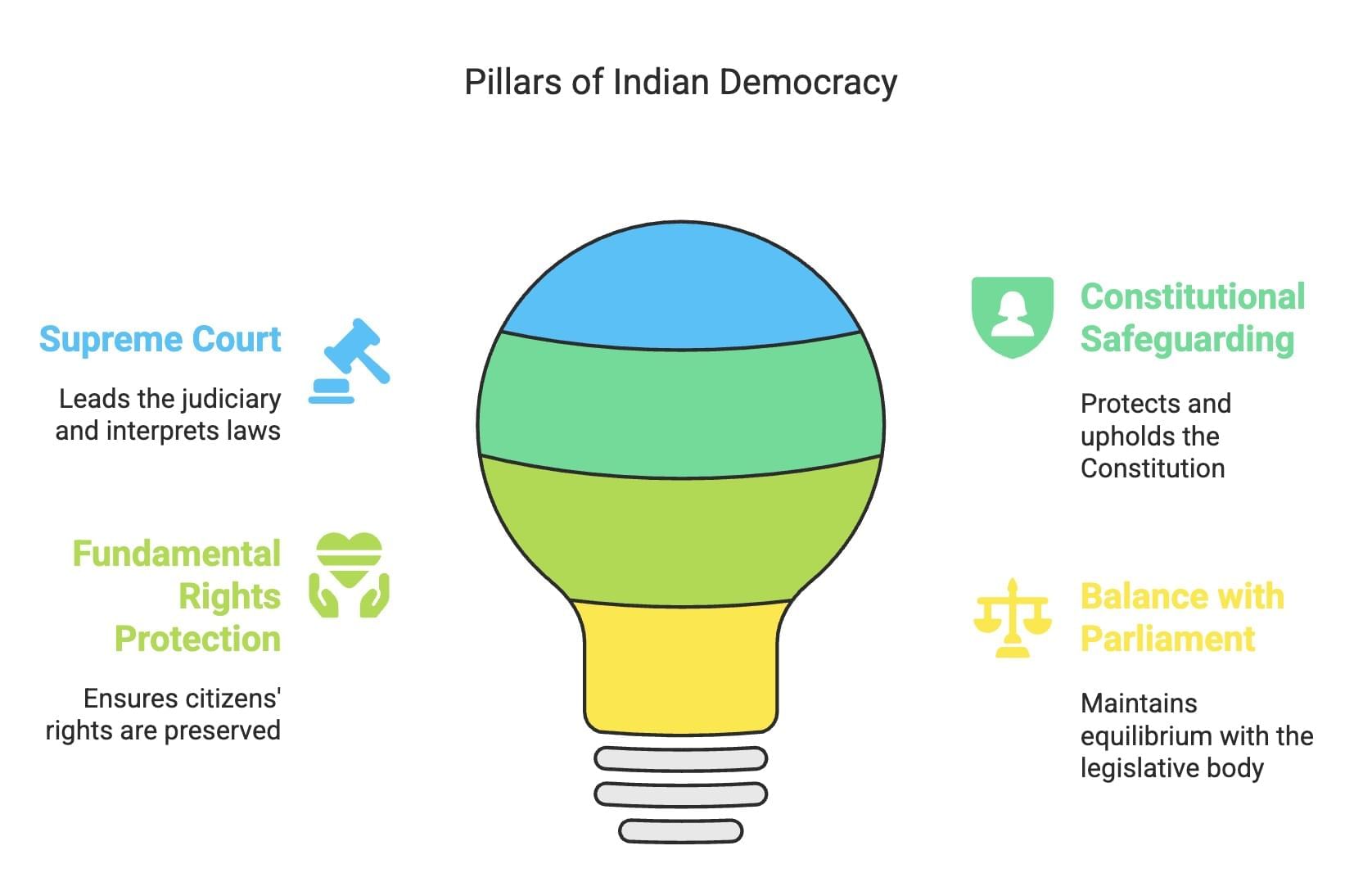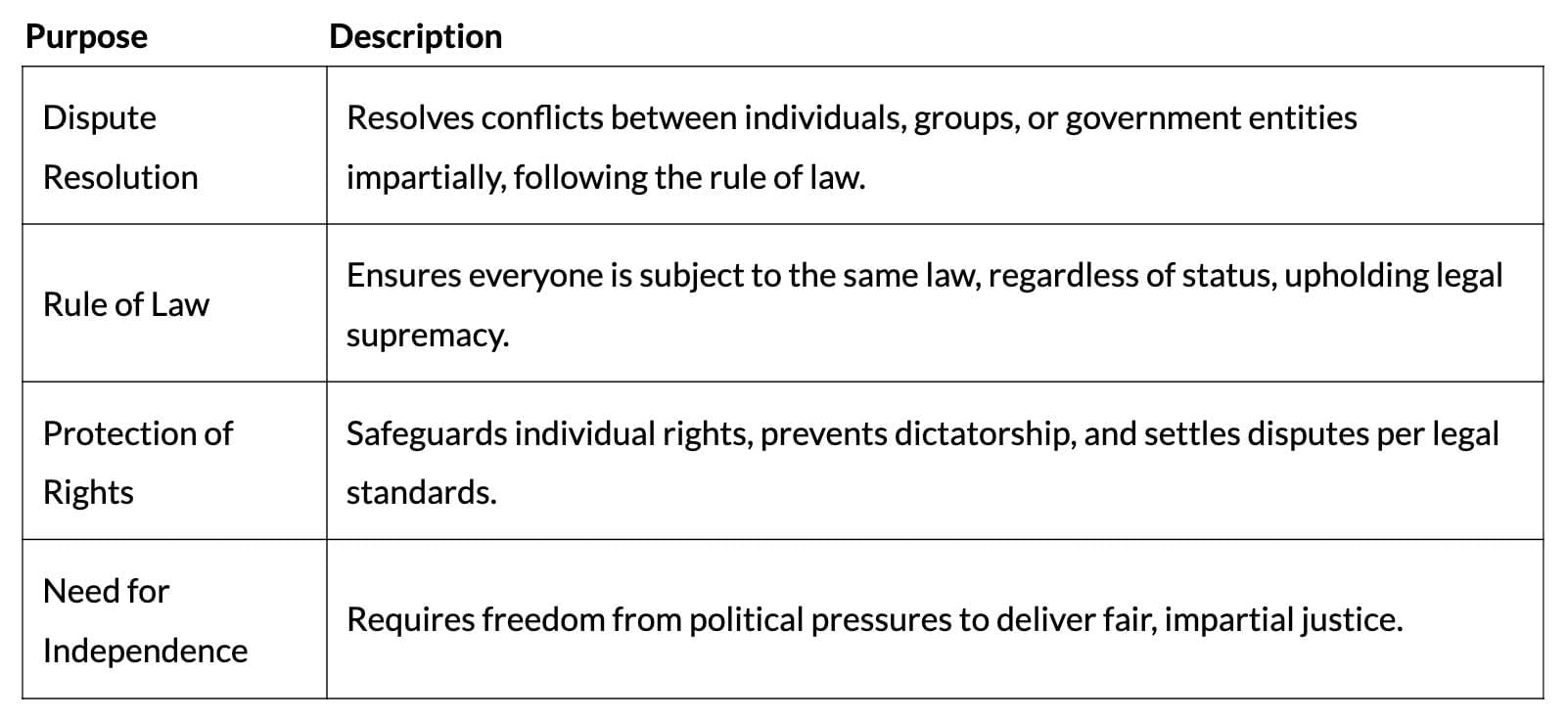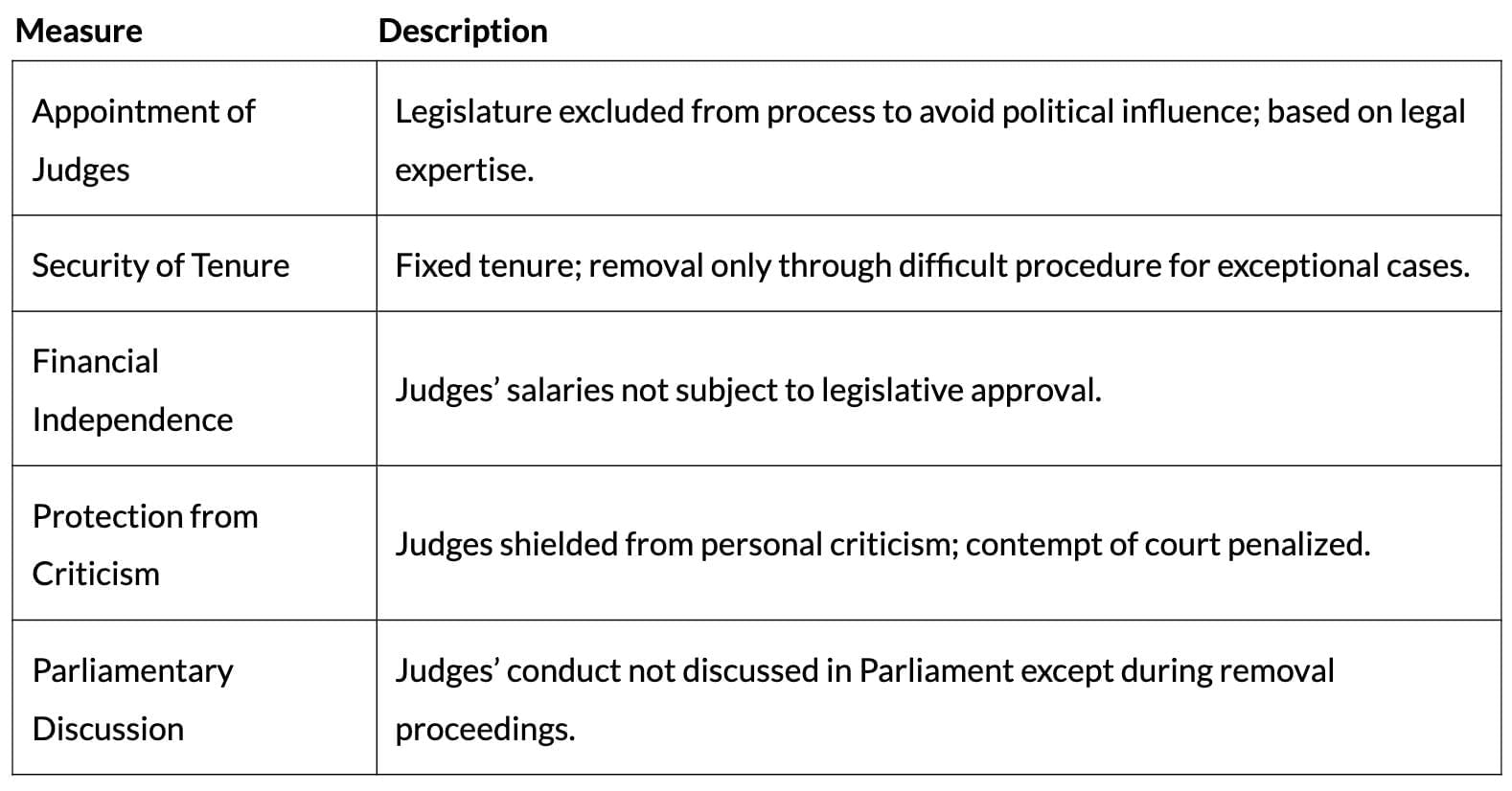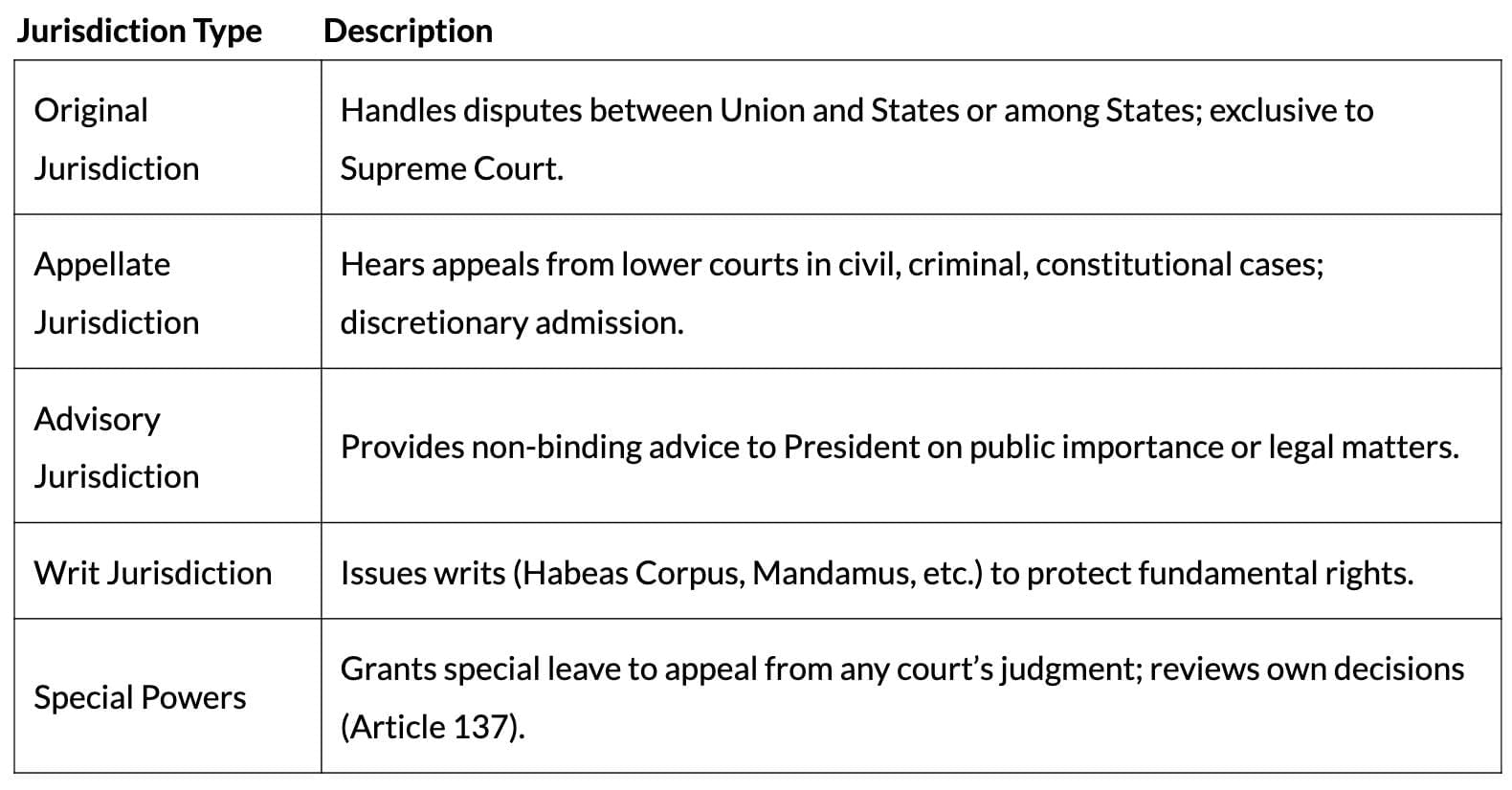Cheat Sheet: Judiciary | Political Science Class 11 - Humanities/Arts PDF Download
The judiciary in India, led by the Supreme Court, is a vital government institution, not just a mediator of disputes but a key player in political functions. Since 1950, it has safeguarded and interpreted the Constitution, protected fundamental rights, and maintained a balance with Parliament, ensuring a robust democracy.

Why Do We Need an Independent Judiciary?

Independence of Judiciary
Key Aspects
- Meaning: The Judiciary operates free from executive and legislative interference in delivering justice.
- Non-Interference: Judges perform duties without fear or favoritism; other branches cannot influence decisions.
- Accountability: Accountable to the Constitution, democratic traditions, and the people, not arbitrary.
Ensuring Independence

Appointment of Judges
Controversies and Processes
- Political Influence: Appointments are controversial due to judges’ political philosophies impacting constitutional interpretation.
- Involved Figures: Council of Ministers, Governors, Chief Ministers, and the Chief Justice of India (CJI) influence the process.
Chief Justice of India
- Traditionally, the senior-most Supreme Court judge is appointed as CJI.
- Exceptions: 1973 (A.N. Ray superseded three seniors), 1975 (M.H. Beg superseded H.R. Khanna).
Other Judges
- Appointed by the President after consulting the CJI; the CJI’s advice is binding per the Supreme Court ruling.
- Collegiality: CJI consults four senior-most judges; their collective recommendations carry significant weight.
Removal of Judges
- Process: Removal only for proven misbehaviour or incapacity; requires a special majority in both Houses of Parliament.
- Special Majority: Higher voting threshold beyond simple majority, ensuring strong consensus.
- Historical Case (1991): Motion against Justice V. Ramaswami for fund misappropriation failed due to Congress's abstention, despite a two-thirds majority among voters.
Structure of the Judiciary
- Integrated System: Single judicial system with no separate State courts; pyramidal structure.
- Hierarchy:
- Supreme Court (top)
- High Courts
- District and subordinate courts (base)
- Supervision: Lower courts operate under higher courts’ oversight.
Jurisdiction of the Supreme Court

- Binding Decisions: Supreme Court rulings bind all lower courts; not bound by their own prior decisions.
- Article 144: All authorities must aid the Supreme Court’s orders.
Judicial Activism and Public Interest Litigation (PIL)
Judicial Activism
- Definition: Proactive judicial role in addressing public interest issues.
- Approach: Shifts from reactive to proactive, engaging with societal concerns.
Public Interest Litigation (PIL)
- Definition: Legal mechanism allowing petitions on behalf of those unable to file, addressing public interest.
- Historical Background: Emerged in 1979; landmark cases include Hussainara Khatoon (1979, under trial prisoners) and Sunil Batra (1980, jail conditions).
- Impact:
- Expanded rights to include clean air, water, and decent living conditions.
- Enhanced executive accountability, electoral transparency (e.g., candidate disclosures).
- Democratised justice access for marginalised groups.
- Criticism: Overburdens courts, blurs the separation of powers by intervening in executive/legislative domains (e.g., pollution, corruption).
- Global Acceptance: PIL is gaining traction in South Asia, Africa; South Africa’s Constitution allows direct rights violation cases.
Judiciary and Rights
- Mechanisms:
- Restoring Fundamental Rights: Issues writs under Article 32 (Supreme Court) and Article 226 (High Courts).
- Declaring Laws Unconstitutional: Strikes down laws under Article 13 if they violate the Constitution.
- Judicial Review: Assesses the law's constitutionality; not explicitly in the Constitution, but implied by its written nature.
- Right Against Exploitation: PIL and activism addressed forced labour, child employment, police abuses, and enhanced rights for marginalised groups.
Judiciary and Parliament
Judicial Review and Constitutional Safeguards
- Reviews actions of the President, Governor, and political practices to protect constitutional principles.
- Initially, some powers were beyond review; now included to prevent constitutional subversion.
Judicial Activism in Administration
- Directs agencies like CBI in high-profile cases (e.g., hawala scandal, Narasimha Rao case, petrol pump allotments).
Separation of Powers and Conflicts

- Early Conflicts: Disputes over the right to property for land reforms; the judiciary ruled fundamental rights cannot be restricted.
- Key Issues (1967-1973): Preventive detention, job reservations, property acquisition, compensation.
- Kesavananda Bharati Case (1973): Established the Constitution’s basic structure, unamendable by Parliament; right to property removed in 1979.
- Ongoing Tensions: Judiciary’s regulation of legislative functions, protection against legislative discipline, and mutual criticisms.
Conclusion
The Indian judiciary, particularly the Supreme Court, is a powerful, independent institution that interprets the Constitution, safeguards rights, and maintains a balance with Parliament. Despite occasional tensions, its prestige has grown through judicial review and activism, notably via PILs. However, concerns such as case backlogs and perceived leniency in high-profile cases highlight ongoing challenges in upholding public trust and maintaining a democratic balance.
|
43 videos|268 docs|39 tests
|
FAQs on Cheat Sheet: Judiciary - Political Science Class 11 - Humanities/Arts
| 1. What is the significance of an independent judiciary in a democratic system? |  |
| 2. How are judges appointed in the judiciary, and what factors influence their selection? |  |
| 3. What are the grounds and procedures for the removal of judges in a democratic system? |  |
| 4. What is the jurisdiction of the Supreme Court, and how does it differ from lower courts? |  |
| 5. How does judicial activism relate to public interest litigation (PIL)? |  |





















